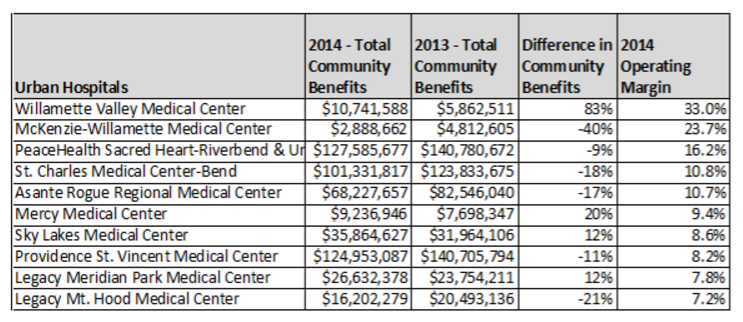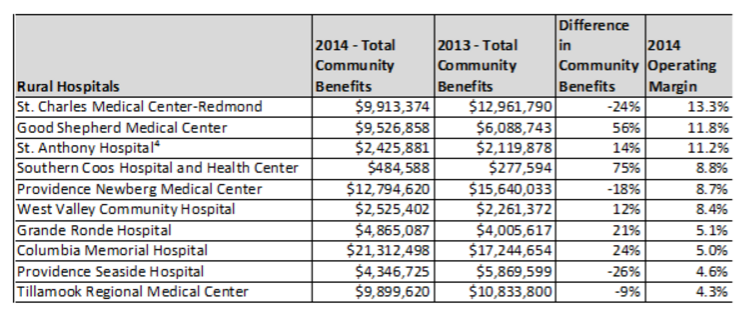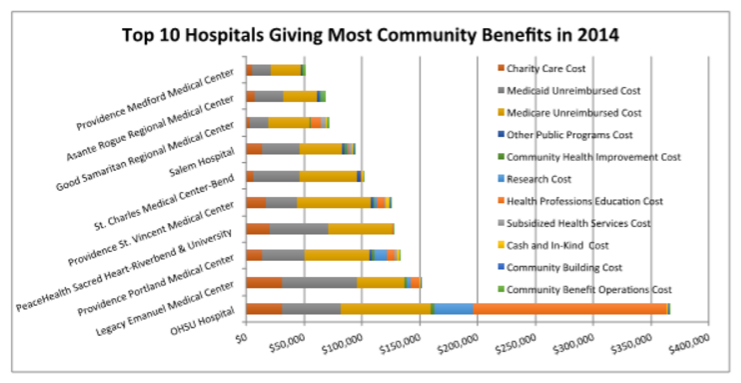One might expect with sharply increasing profits for Oregon’s hospitals in 2014, communities would reap more program benefits, education, research or financial assistance as a result. However, in 2014 this played out for only 31 of Oregon’s 60 hospitals.
Willamette Valley Medical Center topped the list for highest profits in 2014 and highest paid community benefits with 33 percent operating margin (profit) and an astounding 87 percent increase in community benefits over 2013. At the opposite end of the spectrum, McKenzie-Willamette Medical Center with nearly 24 percent operating margin in 2014 decreased its community benefits spending by 40 percent compared to the previous year.
For rural hospitals, Good Shepherd Medical Center with 11.8 percent operating margin in 2014 provided 56 percent more community benefits in 2014 than the previous year. Meanwhile, St. Charles Medical Center-Redmond with 13.3 percent operating margin in 2014 decreased its community benefits spending by 24 percent.
The top 10 highest earning urban hospitals are listed with differences between 2014 and 2013 community benefit amounts. As shown in the table, profits do not determine amount of giving. Six of the top 10 provided less community benefits in 2014 than the previous year.

The top 10 highest earning rural hospitals and corresponding community benefits are listed below. Four of the top 10 rural hospital paid less community benefits in 2014 compared to the previous year.

The Oregon Health Authority (OHA) annual acute care hospital financial highlights revealed trends toward flattening of community benefit costs. In fact, hospitals provided $3.8 million less community benefits in 2014 as compared to 2013 with the lion’s share of the costs going toward unreimbursed Medicaid and Medicare expenses and charity costs.
It’s important to note that Oregon hospitals – to maintain nonprofit status under the 2007 HB 3290 reporting law - are expected to provide measurable benefits to the community. Currently these take the form of financial and subsidized assistance, public programs, community health improvements, in-kind contributions, continuing education for health professionals, research, charity care, and finally, Medicaid and Medicare unreimbursed costs. But there is not a specific amount required by hospitals.
In 2014, hospitals reported unreimbursed Medicaid and Medicare expenses accounted for 66 percent of community benefits. OHA speculated in its financial report that as more Oregonians are insured due to the Affordable Care Act, more are able to pay for medical expenses, and there is less need for hospitals to pay for charity care. In 2014, charity care costs plummeted by 35 percent compared to 2013.
Under the Affordable Care Act, Medicaid and Medicare costs have risen in the past year and consumed more of hospital-provided community benefits. Overall, unreimbursed Medicaid and Medicare costs accounted for 19 to 20 percent of net patient revenues while charity care averaged roughly 2.5 percent (of net patient revenues) in 2014.
To provide some perspective on the share of community benefits consumed by charity care and unreimbursed Medicaid and Medicare, The Lund Report analyzed hospital data to find the top 10 hospitals giving the most community benefits. As shown in the bar chart below, Oregon Health & Science University Hospital provided the highest amount at more than $365 million (with $168 million in educational costs for health professionals). At the bottom end of the top 10, Providence Medford Medical Center gave more than $49 million in community benefits with 85 percent of that ($42 million) going towards unreimbursed Medicaid and Medicare costs.

The Lund report asked Meg Niemi, president of SEIU Local 49, how to interpret recent financial trends showing in OHA’s annual report of higher hospital profits, increasing operational cost, and lower community benefits. Is there a problem with a trajectory showing community benefits gobbled up by unreimbursed Medicaid and Medicare expenses?
“We hear from front-line caregivers in hospitals that they are being asked to do more
with less and the budgets for staffing and supplies are tighter than ever. Meanwhile, many Oregon health systems are making enormous profits and are providing less in terms of community benefits and charity care with the communities they are supposed to serve. We believe that we need to take a serious look at what we expect from hospitals in return for their non-profit, tax-exempt status,” according to Niemi.
Niemi and her research team conducted an analysis revealing the data from alternative perspectives.
“If you look at the OHA report on 2014 Community Benefits and take into account that the 2013 report lacked a full year of reporting for Kaiser Permanente Westside Medical Center and included no data for the Shriner’s hospital, the data shows that in 2014 Oregon Acute Care Hospital’s combined community benefit spending declined by almost $25 million. That’s a substantial decline, especially in light of the more than $700 million in total profit Oregon hospitals earned in 2014.”
In response, Andy Davidson, president and CEO of the Oregon Association of Hospitals and Health Systems asked The Lund Report to publish the following comments, which were not edited and were published in their entirety.
"Oregon hospitals take their commitment to community benefit very seriously, as evidenced by the $1.8 billion in total community benefit in 2014. 2014 was a year of transformation for Oregon’s health care system. Like hospitals in states around the nation that expanded Medicaid, our levels of charity care dropped. That’s a good thing. It means far fewer people in our community lack insurance. For that very reason, hospitals supported the Affordable Care Act, the expansion of Medicaid and $150 billion in Medicare payment cuts to fund the ACA. Despite the vast changes in the health care system in our state, Oregon hospitals stand tall in our community as one of the most important drivers of health improvements. We take our mission very seriously in this regard and strive to align our programs with the needs of our community.
“Anticipating the drop in charity care and looking to offset it in a proactive manner, the Oregon hospitals announced a commitment in March to maintain their community benefit spending starting in 2015. This means that our hospitals and health systems will dedicate more resources to things like community health improvements, research, and other community health related activities. At that time, they also announced a related voluntary policy initiative to provide free care for families who are not Medicaid eligible and whose income is below 200% of the federal poverty level. This program will help ensure that even with Medicaid expansion, those who do not qualify and are unable to attain insurance will receive the hospital care they need. It is estimated that 87,000 Oregonians fall into this category, and providing them with free hospital care builds on the success of Medicaid expansion, which covers people below 139% of the federal poverty level.”
Kathryn can be reached at [email protected].